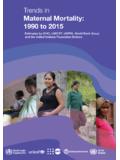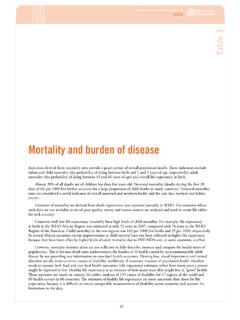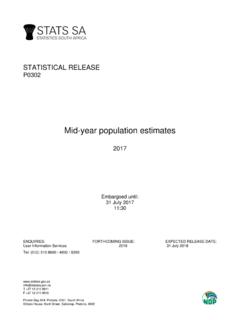Transcription of indicators - WHO
1 2015 Part IIGlobal health indicators4041 General notesThe following summary tables represent the best estimates of WHO for a broad range of key public health indicators based on evidence available at the beginning of 2015. These best estimates have wherever possible been computed by WHO using standardized categories and methods in order to enhance cross-national comparability. In some cases this approach may result in differences between the estimates presented here and the official national statistics prepared and endorsed by individual WHO Member is also important to stress that these estimates are subject to considerable uncertainty, particularly for countries with weak statistical and health information systems where the quality of the underlying empirical data is limited. In addition, it should not be assumed that changes in the values shown for indicators reported on in previous editions of the World Health Statistics series accurately reflect underlying trends.
2 This applies to all types of data and estimates (reported and survey-based data, and modelling-based estimates ) and to all reporting levels (national, regional and global).For indicators with a reference period expressed as a range in Tables 4, 5, 6 and 9, the figure shown is for the most recent year in the range for which data are available unless otherwise noted. For survey data, the year of the report is used to determine the latest available year to be consistent across indicators . For more information on specific years, indicator definitions and metadata please refer to: WHO regional, income-group and global estimates for rates and ratios are population-weighted averages when relevant, while for absolute numbers they are the aggregated sums. Figures are calculated only if data are available for at least 50% of the population within an indicated region or group. For indicators with a reference period expressed as a range, the estimate provided covers the reference period shown in the heading unless otherwise noted.
3 Income-group averages and aggregates, unless otherwise noted, are calculated using the World Bank analytical income clas-sification of economies for fiscal year 2015, which is based on the 2013 Atlas gross national income per capita estimates . indicates data not available or not See Annex 1431. Life expectancy and mortalityThe indicators of life expectancy and mortality presented in Table 1 are: life expectancy at birth; life expectancy at age 60; healthy life expectancy (HALE) at birth; neonatal mortality rate (the probability of death occurring during the first 28 days of life); infant and under-five mortality rates (the probability of dying between birth and 1 year of age, and before 5 years of age, respectively); and adult mortality rate (the probability of dying between 15 and 60 years of age).The estimates of mortality presented here have been derived wherever possible from death-registration data reported annually to WHO.
4 For countries where such data are not available or are of poor quality, estimates of mortality by age and sex were used to construct life tables from which life expectancy was then calculated. Life expectancy at birth reflects the overall mortality level of a population and summarizes the mortality pattern that prevails across all age groups children and adolescents, adults and the elderly. HALE represents the average number of years that a person in a population can expect to live in full health by taking into account years lived in less than full health due to disease and/or recent years, WHO has liaised more closely with the United Nations Population Division in producing life tables for countries in order to maximize the consistency of United Nations and WHO life tables, and to minimize differences in the use and interpretation of available data on mortality the case of child mortality, WHO is part of the Inter-agency Group for Child Mortality Estimation (IGME) which carries out annual updates of estimates for infant and child mortality for UNICEF, WHO and other international agencies.
5 As well as harmonizing the child mortality estimates used by its members, the IGME monitors progress towards the achievement of the relevant MDG target. 1 Child mortality rates measure child survival, and reflect the social, economic and environmental conditions in which children (and others in society) live, including their access to health MDG 4; Target : Reduce by two thirds, between 1990 and 2015, the under-five mortality 4 Member StateLife expectancy at birth a (years) Life expectancy at age 60 a (years) Healthy life expectancy at birth a (years)Neonatal mortality rate (per 1000 live births) bInfant mortality rate(probability of dying by age 1 per 1000 live births) bUnder-five mortality rate b (probability of dying by age 5 per 1000 live births)Adult mortality rate a (probability of dying between 15 and 60 years of age per 1000 population)Member StateBoth sexesMaleFemaleBoth sexesMaleFemaleBoth sexesBoth sexesBoth sexesBoth and and (Plurinational State of) (Plurinational State of)
6 Bosnia and and African African IslandsCosta RicaC te d' te d' RepublicDemocratic People's Republic of People's Republic of KoreaDemocratic Republic of the Republic of the Life expectancy and mortalityTable 145 MDG 4 Member StateLife expectancy at birth a (years) Life expectancy at age 60 a (years) Healthy life expectancy at birth a (years)Neonatal mortality rate (per 1000 live births) bInfant mortality rate(probability of dying by age 1 per 1000 live births) bUnder-five mortality rate b (probability of dying by age 5 per 1000 live births)Adult mortality rate a (probability of dying between 15 and 60 years of age per 1000 population)Member StateBoth sexesMaleFemaleBoth sexesMaleFemaleBoth sexesBoth sexesBoth sexesBoth and and (Plurinational State of) (Plurinational State of)Bosnia and and African African IslandsCosta RicaC te d' te d' RepublicDemocratic People's Republic of People's Republic of KoreaDemocratic Republic of the Republic of the 4 Member StateLife expectancy at birth a (years) Life expectancy at age 60 a (years) Healthy life expectancy at birth a (years)Neonatal mortality rate (per 1000 live births) bInfant mortality rate(probability of dying by age 1 per 1000 live births) bUnder-five mortality rate b (probability of dying by age 5 per 1000 live births)Adult mortality rate a (probability of dying between 15 and 60 years of age per 1000 population)Member StateBoth sexesMaleFemaleBoth sexesMaleFemaleBoth sexesBoth sexesBoth sexesBoth SalvadorEquatorial (Islamic Republic of) (Islamic Republic of)
7 People's Democratic People's Democratic Life expectancy and mortalityTable 147 MDG 4 Member StateLife expectancy at birth a (years) Life expectancy at age 60 a (years) Healthy life expectancy at birth a (years)Neonatal mortality rate (per 1000 live births) bInfant mortality rate(probability of dying by age 1 per 1000 live births) bUnder-five mortality rate b (probability of dying by age 5 per 1000 live births)Adult mortality rate a (probability of dying between 15 and 60 years of age per 1000 population)Member StateBoth sexesMaleFemaleBoth sexesMaleFemaleBoth sexesBoth sexesBoth sexesBoth SalvadorEquatorial (Islamic Republic of) (Islamic Republic of) People's Democratic People's Democratic 4 Member StateLife expectancy at birth a (years) Life expectancy at age 60 a (years) Healthy life expectancy at birth a (years)Neonatal mortality rate (per 1000 live births) bInfant mortality rate(probability of dying by age 1 per 1000 live births) bUnder-five mortality rate b (probability of dying by age 5 per 1000 live births)Adult mortality rate a (probability of dying between 15 and 60 years of age per 1000 population)Member StateBoth sexesMaleFemaleBoth sexesMaleFemaleBoth sexesBoth sexesBoth sexesBoth (Federated States of) (Federated States of) New New of of KoreaRepublic of of Kitts and Kitts and NevisSaint LuciaSaint Vincent and the Vincent and the Life expectancy and mortalityTable 149 MDG 4 Member StateLife expectancy at birth a (years) Life expectancy at age 60 a (years) Healthy life expectancy at birth a (years)Neonatal mortality rate (per 1000 live births) bInfant mortality rate(probability of dying by age 1 per 1000 live births) bUnder-five mortality rate b (probability of dying by age 5 per 1000 live births)
8 Adult mortality rate a (probability of dying between 15 and 60 years of age per 1000 population)Member StateBoth sexesMaleFemaleBoth sexesMaleFemaleBoth sexesBoth sexesBoth sexesBoth (Federated States of) (Federated States of) New New of of KoreaRepublic of of Kitts and Kitts and NevisSaint LuciaSaint Vincent and the Vincent and the 4 Member StateLife expectancy at birth a (years) Life expectancy at age 60 a (years) Healthy life expectancy at birth a (years)Neonatal mortality rate (per 1000 live births) bInfant mortality rate(probability of dying by age 1 per 1000 live births) bUnder-five mortality rate b (probability of dying by age 5 per 1000 live births)Adult mortality rate a (probability of dying between 15 and 60 years of age per 1000 population)Member StateBoth sexesMaleFemaleBoth sexesMaleFemaleBoth sexesBoth sexesBoth sexesBoth sexesMaleFemale1990201319902013199020131 9902013199020131990201320131990201319902 00020131990200020131990201319902013 San MarinoSao Tome and Tome and PrincipeSaudi AfricaSouth Arab Arab former Yugoslav Republic of former Yugoslav Republic of and and Arab Arab EmiratesUnited KingdomUnited Republic of Republic of TanzaniaUnited States of States of (Bolivarian Republic of) (Bolivarian Republic of)Viet Life expectancy and mortalityTable 151 MDG 4 Member StateLife expectancy at birth a (years) Life expectancy at age 60 a (years) Healthy life expectancy at birth a (years)Neonatal mortality rate (per 1000 live births) bInfant mortality rate(probability of dying by age 1 per 1000 live births)
9 BUnder-five mortality rate b (probability of dying by age 5 per 1000 live births)Adult mortality rate a (probability of dying between 15 and 60 years of age per 1000 population)Member StateBoth sexesMaleFemaleBoth sexesMaleFemaleBoth sexesBoth sexesBoth sexesBoth sexesMaleFemale1990201319902013199020131 9902013199020131990201320131990201319902 00020131990200020131990201319902013 San MarinoSao Tome and Tome and PrincipeSaudi AfricaSouth Arab Arab former Yugoslav Republic of former Yugoslav Republic of and and Arab Arab EmiratesUnited KingdomUnited Republic of Republic of TanzaniaUnited States of States of (Bolivarian Republic of) (Bolivarian Republic of)Viet 4 Member StateLife expectancy at birth a (years) Life expectancy at age 60 a (years) Healthy life expectancy at birth a (years)Neonatal mortality rate (per 1000 live births) bInfant mortality rate(probability of dying by age 1 per 1000 live births) bUnder-five mortality rate b (probability of dying by age 5 per 1000 live births)Adult mortality rate a (probability of dying between 15 and 60 years of age per 1000 population)Member StateBoth sexesMaleFemaleBoth sexesMaleFemaleBoth sexesBoth sexesBoth sexesBoth sexesMaleFemale1990201319902013199020131 9902013199020131990201320131990201319902 00020131990200020131990201319902013 Ranges of country regionAfrican RegionRegion of the of the AmericasSouth-East Asia Asia RegionEuropean RegionEastern Mediterranean Mediterranean RegionWestern Pacific Pacific RegionIncome groupLow incomeLower middle middle incomeUpper middle middle incomeHigh Mortality and global health estimates [online database].
10 Geneva: World Health Organization; 2014 ( ). Income groups were derived using the 2013 World Bank list of economies. South Sudan is included in the WHO Eastern Mediterranean Region for consistency of time series with World Health Statistics 2014 Levels & Trends in Child Mortality. Report 2014. estimates Developed by the UN Inter-agency Group for Child Mortality Estimation. New York: UNICEF; 2014 ( , accessed 6 April 2015).c. Turkey has recently improved its vital registration system and reported an infant mortality of per 1,000 live births for 2013 ( ). An assessment of death registration coverage for years 2009-2011 showed 90% completeness for adult deaths. Completeness of child death registration is likely to be somewhat Life expectancy and mortalityTable 153 MDG 4 Member StateLife expectancy at birth a (years) Life expectancy at age 60 a (years) Healthy life expectancy at birth a (years)Neonatal mortality rate (per 1000 live births) bInfant mortality rate(probability of dying by age 1 per 1000 live births) bUnder-five mortality rate b (probability of dying by age 5 per 1000 live births)Adult mortality rate a (probability of dying between 15 and 60 years of age per 1000 population)














